An investigation on neutron induced reactions on stable CNO isotopes?
MA Chun-Wang(馬春旺),L¨U Cui-Juan(呂翠娟),WEI Hui-Ling(魏慧玲),and CAO Xi-Guang(曹喜光)
1Institute of Particleamp;Nuclear Physics,Henan Normal University,Xinxiang 453007,China
2Shanghai Institute of Applied Physics,Chinese Academy of Sciences,Shanghai 201800,China
An investigation on neutron induced reactions on stable CNO isotopes?
MA Chun-Wang(馬春旺),1,?L¨U Cui-Juan(呂翠娟),1WEI Hui-Ling(魏慧玲),1and CAO Xi-Guang(曹喜光)2
1Institute of Particleamp;Nuclear Physics,Henan Normal University,Xinxiang 453007,China
2Shanghai Institute of Applied Physics,Chinese Academy of Sciences,Shanghai 201800,China
The neutron induced reactions on stable Carbon,Nitrogen,and Oxygen isotopes are investigated by using the Talys1.4 toolkit with the default parameters.The neutron incident energy covers a range from 0.20MeV to 85.00MeV.For12C and14N,the Talys1.4 results agree with the experimental data,while the parameters should be adjusted for16O.Some Enwindows are found by comparing the main channels of n+C/N/O reactions, which induce element change.In these Enwindows,a specific element is activated to a different one while leaving the other element atoms unchanged.The results will facilitate the research of doping effects in organic materials by using neutron activation technique.
Neutron activation,Doping,Organic material,C/N/O activation
I.INTRODUCTION
Doping is an important method to change the properties of materials.For example,the substitutions of some atoms in organic semi-conductors promote the charge transport and stability greatly[1,2].The general method for doping is chemical synthesis which introduces new elements into the original material.Actually,neutron activation is an important method to make doping in material,which can even change one element to other one,directly or after the decay of unstable isotopes produced by activation.In this situation,different to the chemical doping,different doping effects can be expected.
It is well known that for different nuclei,there are different threshold energy values for specific channels in neutron induced reactions[3].For material having different elements, the different threshold energy values for neutron reactions provide a chance for specific activation if the neutron energy is selected in experiments.
In this article,the neutron induced reactions on stable carbon,nitrogen,and oxygen isotopes will be investigated by usingaTalystoolkit.Theenergywindowsbetweenthedifferent isotopes will be analyzed.The theory is briefly discussed in Sec.II.The results are discussed in Sec.III,and a summary is presented in Sec.IV.
II.METHODS
The optical model can describe the neutron induced reaction well in a wide range of incident energies.In Talys1.4,the ECIS-06 is implanted as a subroutine to deal with the optical model calculations[4].The description of Talys1.4 and the implanted functions can be found in the user manual[5,6].
In statistical models for predicting cross sections,nuclear level densities are used at excitation energies where discrete level informationis notavailable orincomplete.Severalmodels are implanted to describe the level density in Talys,which range from phenomenological analytical expressions to tabulated level densities derived from microscopic models.The constant temperature and Fermi-gas model is set as the default parameter of level density at low excitation energy region,while the Fermi-gas model is used in the high excitation energy region[6].
Due to the threshold energy exists for different channels in the neutron induced reaction on a nucleus,one channel can only happen if the incident energy of the neutron is above the threshold,which potentially provides energy windows only one channel can happen while the other channels are prohibited.In this work,the incident energy of the calculated reactions ranges from 0.20MeV to 85.00MeV,and the default parameters in Talys1.4 are adopted.The main reaction channels include(n,np),(n,p),(n,α),(n,2n)and(n,γ).The calculated results are compared to the measured data,which are extracted from the EXFOR library provided by the National Nuclear Data Center(NNDC)[7].All the natural abundance data and the half-life time of isotopes are taken from Wikipedia[8].
III.RESULTS AND DISCUSSION
A.neutron induced reactions on carbon isotopes
The C element has two stable isotopes,12C and13C,with natural abundances of 98.93%and 1.07%,respectively.Only the n+12,13C reactions are calculated.
1.n+12C reactions
The12C(n,p)12B,12C(n,α)9Be,and12C(n,2n)11C channels have been measured previously.12B is an unstable nucleus,which decays to12C via electron emission with a half-life time of 20.20ms.9Be is a stable isotope.11C is also unstable,which decays to11B via positron emission with a relative long half-life time of 20.334min.Thus the12C(n,2n)11C and12C(n,np)11B channels are the main channels which result in element changes with the same final products,11B. The results are plotted in Fig.1.
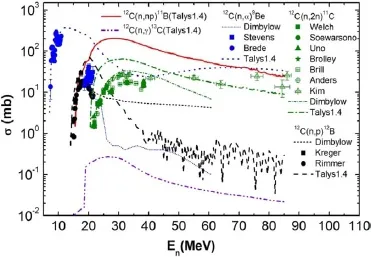
Fig.1.(Color online)The yield of residues produced in n+12C reactions.The measured results are denoted by symbols,and the calculated results are represented by lines.
First,for the12C(n,α)9Be channel,the Talys1.4 results are consistent with the measured results when En<11.00MeV[9],while the Talys1.4 results differ largely with the results measured by Stevens et al.[10]in the range of 18.65MeV < En< 21.46MeV.In the energy range of 20.00MeV < En< 60.70MeV,the Talys1.4 results are also much larger than the calculated results by Dimbylow et al.[11].Above En> 11.00MeV,the results of the12C(n, α)9Be channel have large difference,which suggests that further experiment should be performed for a systematic understanding.
Second,for the12C(n,p)12B channel,the measured results by Kreger et al.[12]and Rimmer et al.[13]coincide when En<16.00MeV,but differ when Enis higher. The Talys1.4 results agree well with the measured results when En< 16.00MeV,but overestimate the measured results by Kreger et al.[12]in the range of 16.00MeV <En< 22.00MeV.The calculated results of12C(n,p)12B in the range of 20.00MeV< En< 60.70MeV by Dimbylow et al.[11],which also uses the optical model,prefer the measured results by Kreger et al.[12].Meanwhile,the Talys1.4 predicts similar results between12C(n,p)12B and12C(n,np)11B reactions when En<20.00MeV.
Third,forthe12C(n,2n)11Cchannel,whichhavebeenmeasured by many groups,the measured data agree well when En<27.00MeV.The results can be divided into two groups in the range of 27.00MeV<En<40.00MeV,of which the upper group was measured by Welch et al.[14],Anders et al.[15],and Kim et al.[16];and the bottom group by Brill et al.[17],Uno et al.[18],Brolley et al.[19],and Soewarsono et al.[20].The calculated results by Dimbylow et al.[11]prefer the upper group results when En< 35.00MeV.Kim et al.[16]measured the results in the energy range from 55.00MeV to 64.00MeV.The calculated results by Talys1.4 largely overestimate the measured ones when En<50.00MeV,but agree with the measured results by Kim et al.[16].The calculated results by Dimbylow et al.[11]underestimate the measured results by Kim et al.[16].
The threshold energies of the12C(n,α)9Be,12C(n,p)12B,12C(n,np)11B and12C(n,2n)11C channels increase,which are about 6.18MeV,13.64MeV,14.89MeV and 20.30MeV,respectively.The12C(n,γ)13C channel happens in the whole energy range,but have a much smaller probability compared to other channels.
2.n+13C reactions
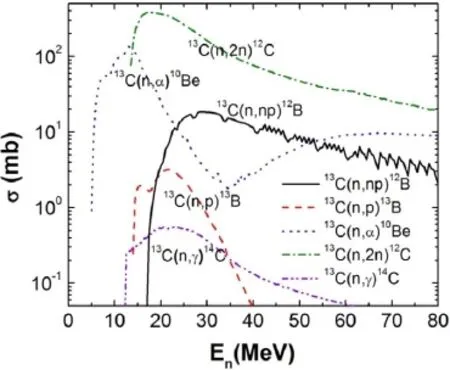
Fig.2.(Color online)The yield of residues produced in the different channels of the n+13C reactions calculated by Talys1.4.
No measured data for the neutron induced reactions on13C is found.The Talys1.4 calculated results are plotted in Fig.2.The threshold energy values increase with the(n,α), (n,2n),(n,p)and(n,np)channels,with the values 4.13MeV, 5.33MeV,13.64MeV and 16.50MeV,respectively.The(n, γ)channel has no lowest energy threshold.The(n,γ)and (n,p)channels have relatively low probabilities compared to the other channels.In the whole energy range calculated, when En<15.00MeV,the main channel is13C(n,α)10Be, in which10Be decays to10B by electron emission with a very long half-life time 1.39×106years;when En>15.00MeV, the dominant channel is13C(n,np)12B,in which12B mainly decays to12C with a half-life time 20.20ms.
B. Neutron induced reactions on nitrogen isotopes
The N element has two stable isotopes,14N and15N,with a natural abundance of 99.64%and 0.36%,respectively.Only the n+14,15N reactions are calculated.
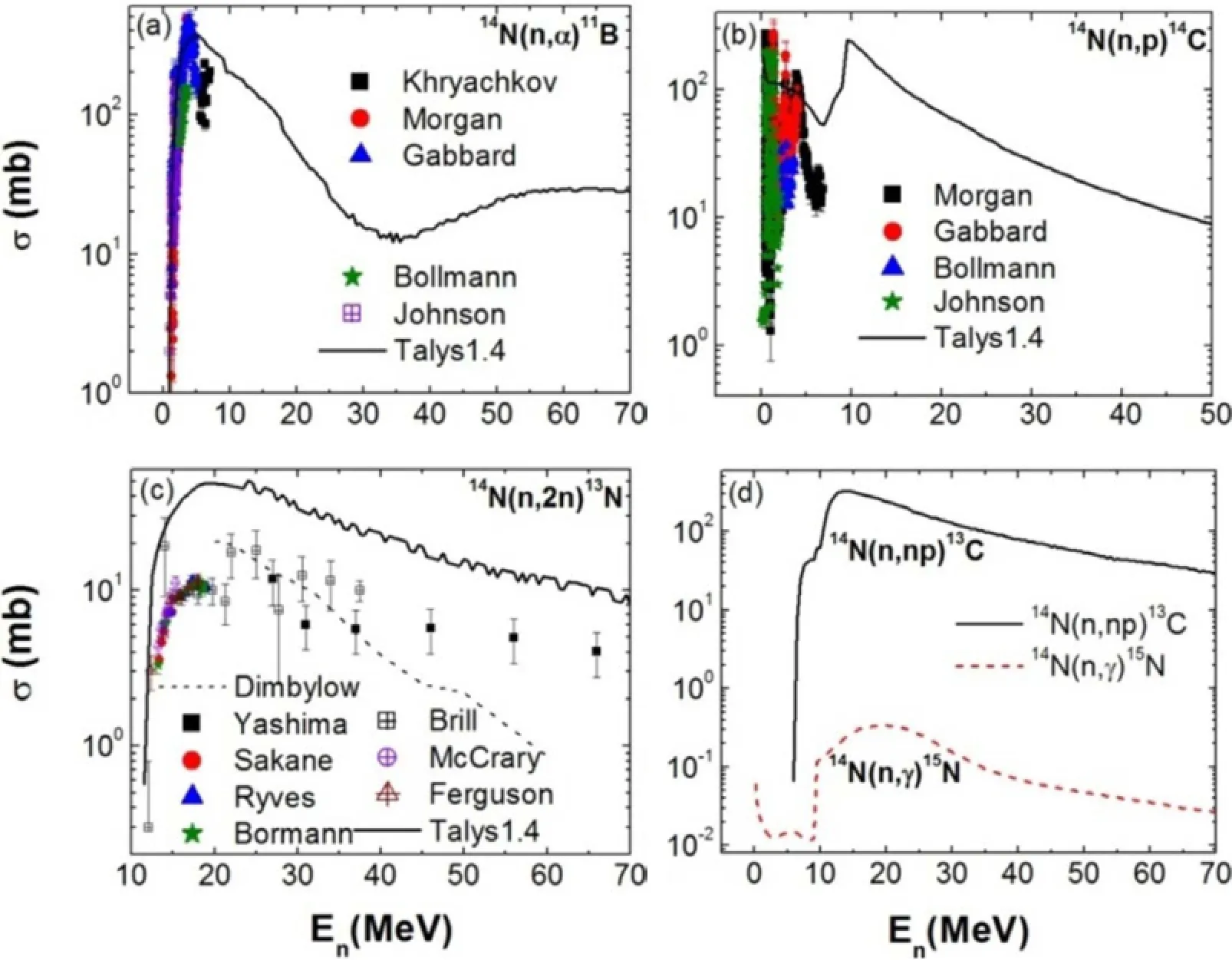
Fig.3.(Color online)The yield of residues produced in the different channel of n+14N reactions:(a)14N(n,α)11B;(b)14N(n,p)14C;(c) 14N(n,2n)13N;and(d)14N(n,np)13C and14N(n,γ)15N.The calculated results are plotted as different lines.
1. n+14N reactions
The calculated channels for the n+14N reaction are14N(n, np)13C,14N(n,p)14C,14N(n,α)11B,14N(n,γ)15N,and14N(n, 2n)13N reactions,respectively.The nuclei13C,15N,and11B are stable,while14C and13N are unstable.13N decays to13C by positron emission with a half-life time 9.965min.The(n, np),(n,p),(n,2n),and(n,α)channels are the main ones which will result in element changes.
The results of the n+14N reaction are plotted in Fig.3.For clarity,the results are plotted in different panels.The14N(n, α)11B and14N(n,p)14C have small threshold energies,which are very similar.The14N(n,α)11B channel has been measured by different groups[21–25],and the14N(n,p)14C has also been measured[21,23–25].For the two channels,the data measured by different groups is consistent.The Talys1.4 results agree with the measured data in the low incident energies,but overestimate the measured results when the Enincreases.
For the14N(n,2n)13N channel,the measured results[26–30]are consistent when En< 19.00MeV.When En>24.00MeV,the measured results by Brill et al.[17]and Yashima et al.[31]are relatively consistent,and the calculated results by Dimbylow et al.[11]also agree with the measured data but have relatively large errors.The predicted threshold energy value by Talys1.4 is En≈11.00MeV,but the Talys1.4 cross sections overestimate the measured results in the whole energy range,which increases fast with Enand reaches maximum at En=24.00MeV and decreases with Enwhen En> 24.00MeV.Since13N decays to13C,the final production is the same as the14N(n,np)13C channel. The14N(n,np)13C channel has a low threshold energy value of about 6.00MeV,and the cross section of the channel increase fast with En,which peaks at about En=14.00MeV.
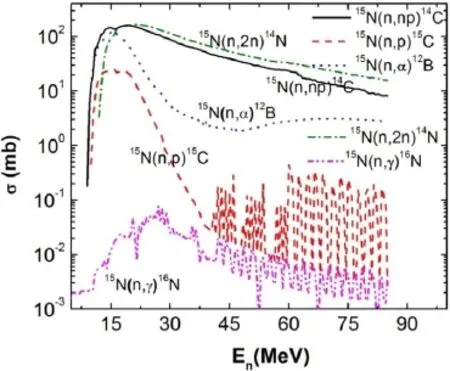
Fig.4.(Color online)The yield of residues produced in the different channel of the n+15N reactions calculated by Talys1.4.
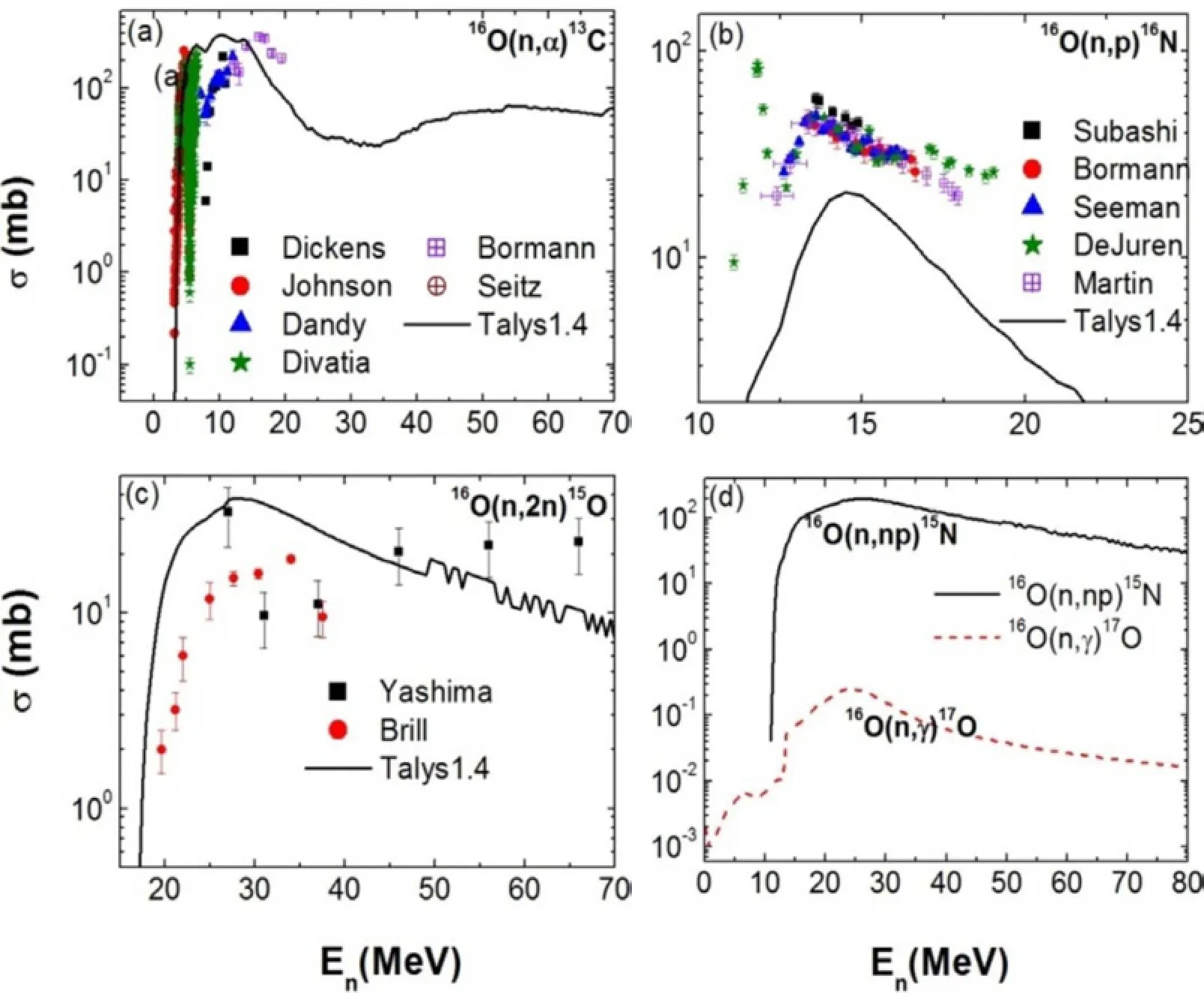
Fig.5.(Color online)The yield of residues produced in different channels of n+16O reaction.(a)16O(n,α)13C;(b)16O(n,p)16N;(c)16O(n, 2n)15O;and(d)16O(n,np)15N and16O(n,γ)17O.The results calculated by Talys1.4 are plotted as lines.
The threshold energies increase in the order of(n,α), (n,np),and(n,2n),which are about 0.13MeV,5.67MeV and 11.27MeV,respectively.The(n,γ)and(n,p)channel happens in the whole Enrange and forms a peak around 19.00MeVand 9.50MeV with a wide width,but the cross sections are very small compared to other channels.
2. n+15N reactions
No measured data for the n+15N reaction is found.Only the Talys1.4 calculated results are plotted in Fig.4.The calculated results for the(n,np)and(n,α)channels have almost the same values when En<12.00MeV and the(n,np)channel has much larger values than that of the(n,α)channel.At the same time,the cross sections of(n,p)and(n,2n)channels only have small difference when En>17.00MeV.The (n,np),(n,α),(n,p),and(n,2n)channels have relatively similar threshold energy values,which are about 8.57MeV, 8.09MeV,9.55MeV and 11.56MeV,respectively. The cross sections of the(n,γ)channel are much smaller compared to the other channels.When En>40.00MeV,large fluctuations are found in the results of the(n,p)and(n,γ) channels.
C. Neutron induced reactions on oxygen isotopes
The O element has three stable isotopes,16O,17O,and18O, with a natural abundance of 99.75%,0.0038%,and 0.205%. Only the n+16,18O reactions are calculated.
1. n+16O reactions
In Fig.5,the results of the n+16O reactions are plotted.The channels include16O(n,α)13C,16O(n,p)16N,16O(n, 2n)15O,16O(n,np)15N,and16O(n,γ)17O.16N decays to16O by emitting electron with a half-life time of 7.13s.Thus the main channels which make the element change are16O(n, α)13C and16O(n,np)15N.
For the16O(n,α)13C channel,the Talys1.4 calculated results are consistent with these measured by Johnson et al.[32],andSeitz etal.[33]exceptthose byDivatia etal.[34] when Enis smaller than 5.00MeV.When En>7.00MeV, the measured results by Dickens et al.[35],Bormann et al.[36],and Dandy et al.[37]are consistent,but the Talys1.4 calculated results are unable to reproduce measured data well.
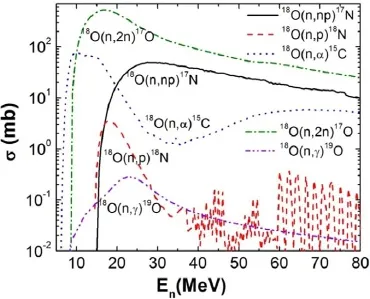
Fig.6. (Color online)The yields of residues produced in the different channels of the n+18O reactions calculated by Talys1.4.
For the16O(n,p)16N channel,the measured results by Martin et al.[38],Bormann et al.[39],and Seeman et al.[40] agree well.The measured results by Subashi et al.[41]and DeJuren et al.[42]also agree with those results but have relatively large difference.The Talys1.4 calculated results largely underestimate the measured results but have similar trend to the measured ones.
For the16O(n,2n)15O channel,the measured results by Yashima et al.[33]and Brill et al.[17]are in different energy ranges,but for the overlapping range of En,the results have some difference.The Talys1.4 results overestimate the measured ones when En<40.00MeV,but underestimate the measured ones when En>40.00MeV.
The16O(n,np)15N and16O(n,γ)17O channels have not been measured.For the16O(n,np)15N channel,the probability increases fast above the threshold energy of 10.57MeV and has a maximum value around En=20.00MeV.The16O(n,γ)17O channel happens in the whole Enrange but have much smaller values.
The Talys1.4 calculated threshold energies of the(n,α), (n,p),(n,np)and(n,2n)channels for16O are 2.36MeV, 10.25MeV,10.57MeV and 16.65MeV,with peaks form at around 10.00MeV,14.50MeV,26.00MeV and 28.00MeV, respectively.
2.n+18O reactions
The main channels that the n+18O reactions cover are18O(n,α)15C,18O(n,np)17N,18O(n,p)18N,18O(n,2n)17O, and18O(n,γ)19O.17N can decay to16O and17O with a halflife time of 4.173s;18N can decay to18O,14C,or17O with a half-life time of 622ms,which are all stable nuclei(14C has a very long half-life time).
In Fig.6,the calculated results for the channels are plotted. The thresholds of the(n,α),(n,2n),(n,p), and(n,np)channels are 5.29MeV,8.49MeV,13.85MeV and 14.49MeV,and the peaks form at around 10.00MeV, 17.00MeV,18.00MeV and 49.50MeV,respectively.When En> 33.00MeV,the yield of the(n,p)channel has large fluctuations with En.
D.Comparison between main channels of n+C/N/O isotopes
The differences between the threshold energies of the different channels make it possible to change one element to another. To change the element in organic materials specifically,the incident energy of the neutron should be selected to fit the energy window,as has been illustrated in the results above.The comparison between the thresholds of the main channel inducing element changes will show the Enwindow more clearly.
For12C,both the final production of12C(n,np)11B and12C(n,2n)11C are11B since11C decays to11B via positron emission with a half-life time of 20.30ms.The threshold energy of12C(n,α)9Be is about 6.18MeV.When En>7.00MeV,12C can be changed to9Be.The threshold energy of12C(n,np)11B is about 14.89MeV.When En>16.00MeV,12C can be changed to9Be and11B.This provides actual application of neutron activation on C isotopes. The chemically synthesized compound,in which a C atom is substituted by a B atom,demonstrates a novel molecular engineering concept of organic semiconductors[43].For14N,the most important channel is(n,2n),which happens at very low neutron incident energy.Since the final yields in the n+14,15N reactions are mainly carbon isotopes,we do not discuss the energy window for these channels.For16O, the main channels are16O(n,α)13C and16O(n,np)15N when En<15.00MeV,withtheproductionof13Cand15N,respectively.There is also an Enwindow between the two channels in the range from 4.00MeV to 11.00MeV.With larger En, the16O(n,2n)15O channel is opened.15O decays to14N by emitting a positron with a half-life time of 70.60s,i.e.,16O is changed to14N finally.
For a better understanding of the energy windows,the energy above the Talys calculated threshold energy for each channel is plotted in Fig.8.The numbers from 1 to 24 represent the channels and the alphabet from a to w represent the values of the threshold energies,of which are also listed as follows(the unit is MeV):1,En=0 for the14N(n,p)14C and(n,γ)channel of C/N/O;2,14N(n,α)11B (a=0.13);3,16O(n,α)13C(b=2.36);4,13C(n,α)10Be (c=4.13);5,18O(n,α)15C(d=5.29);6,13C(n,2n)12C (e=5.33);7,14N(n,np)13C(f=5.67);8,12C(n,α)9Be (g=6.18);9,15N(n,α)12B(h=8.09);10,18O(n,2n)17O (i=8.49);11,15N(n,np)14C(j=8.57);12,15N(n,p)15C (k=9.55);13,16O(n,p)16N(l=10.25);14,16O(n,np)15N (m=10.57);15,14N(n,2n)13N(n=11.27);16,15N(n, 2n)14N(o=11.56);17,13C(n,p)13B(p=13.635);18,12C(n,p)12B(q=13.645);19,18O(n,p)18N(r=13.85);20,18O(n,np)17N(s=14.49);21,12C(n,np)11B(t=14.89);22,13C(n,np)12B(u=16.49);23,16O(n,2n)15O(v=16.65); 24,12C(n,2n)11C(w=20.30).Though the energy windows are clearly shown in Fig.8,it should be carefully analyzed when the neutron is used to activate special compounds,including different elements.
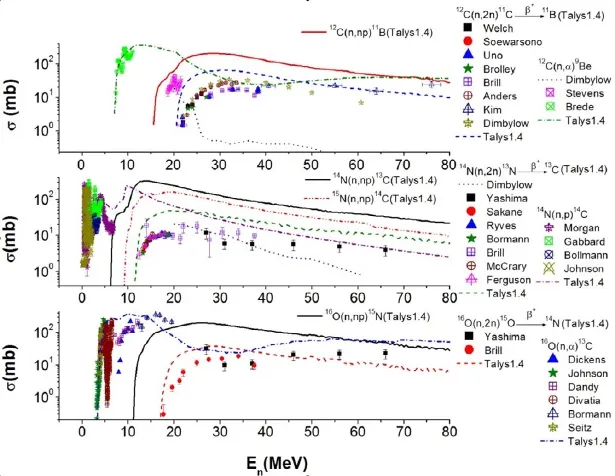
Fig.7.(Color online)Comparison among the results of the main channels of n+C/N/O reactions which induce element changes.
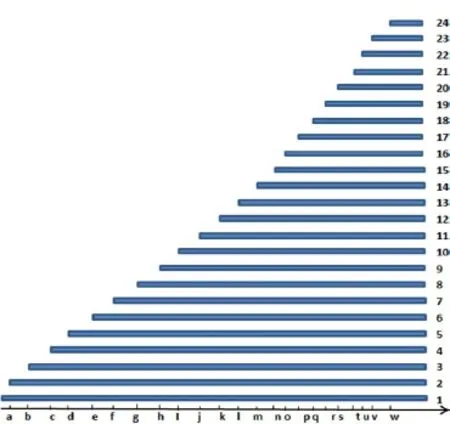
Fig.8.(Color online)The comparison among the threshold energies of different channels which induce element changes(See the text for explanation).
IV.CONCLUSION
In this article,the neutron induced reactions on the stable C,N,and O isotopes are investigated by using the Talys1.4 toolkit,which calculates the reactions in the framework of optical model.On the one hand,it is found that for12C and14N, the Talys1.4 results agree with the experimental data,while for16O,the parameters in Talys1.4 should be adjusted for a better prediction.On the other hand,a systematic comparison among the main channels of n+C/N/O reactions which induce element change are performed to find Enwindows among the original C,N,and O stable isotopes(by considering the final production of the channel,i.e.,direct change or indirect change through decay to a different element isotope). In these Enwindows,specific elements can be activated to a different one while leaving the other element unchanged.The results may help to study material modification by using neutron induced doping techniques such as in organic materials like the organic semiconductor.
[1]Ikai M,Tokito S,et al.Appl Phys Lett,2001,79:156–158.
[2]Scherf U and List E J W.Adv Mater,2002,14:477–487.
[3]Ding D Z,Ye C T,Zhao Z X,et al.Neutron Physics.Bejing (China):Atomic Energy Publishing,2005.
[4]Raynal J.Notes on ECIS94,CEA Saclay Report No.CEA-N-2772,1994.
[5]Ma C W,Jing R Y,Feng X,et al.Chinese Phys C,2014.(in press)
[6]Koning A J,Hilaire S,Duijvestijn M C,et al.User Manual of Talys-1.4.(http://www.talys.eu/_leadmin/ talys/user/docs/talys1.4.pdf).
[7]https://www-nds.iaea.org/exfor/exfor.htm
[8]http://en.wikipedia.org/wiki/Isotope
[9]Brede H J,Dietze G,Klein H,et al.Nucl Sci Eng,1991,1: 22–34.
[10]Stevens A P.INIS microfiche,No.3596,1976.
[11]Dimbylow P J.Phys Med Biol,1980,4:637–649.
[12]Kreger W E and Kern B D.Phys Rev,1959,113:890–894.
[13]Rimmer E M and Fisher P S.Nucl Phys A,1968,108:567–576.
[14]Welch P,Johnson J,Randers-Pehrson G,et al.B Am Phys Soc, 1981,26:708.
[15]Anders B,Herges P,Scobel W.Z Phys A-Hadron Nucl,1981, 4:353–361.
[16]Kim E,Nakamura T,Konno A,et al.Nucl Sci Eng,1998,129: 209–223.
[17]Brill O D,Vlasov N A,Kalinin S P,et al.Dokl Akad Nauk+, 1961,1,55.
[18]UnoY,UwaminoY,SoewarsonoTS,etal.NuclSciEng,1996, 122:247–257.
[19]Brolley J E,Jr,Fowler J L,et al.Phys Rev,1952,88:618–621.
[20]Soewarsono T S,Uwamino Y,Nakamura T.JAERI-M Reports, No.92,027,354,1992.
[21]Gabbard F,Bichsel H,Bonner T W.Nucl Phys,1959,14:277–294.
[22]Khryachkov V Y,Kuzminov B D,Dunaev M V,et al.Atomnaya Energiya,2006,101:760–765.
[23]Morgan G L.Nucl Sci Eng,1979,70:163–176.
[24]Johnson C H and Barschall H H.Phys Rev,1950,80:818–823.
[25]Bollmann W and Zuenti W.Helve Phys Acta,1951,24:517–550.
[26]SakaneH,KasugaiY,ShibataM,etal.AnnNuclEnergy,2001, 28:1175–1192.
[27]RyvesTB,KolkowskiP,ZiebaKJ.JPhysGNuclPartic,1978, 4:1783–1792.
[28]Bormann M,Fretwurst E,Schehka P,et al.Nucl Phys,1965, 63:438–448.
[29]Mc Crary J H and Morgan I L.B Am Phys Soc,1960,5:246.
[30]Ferguson J M and Thompson W E.Phys Rev,1960,118:228–232.
[31]Yashima H,Terunuma K,Nakamura T,et al.J Nucl Sci Technol,2004,4:70–73.
[32]Johnson C H,Fowler J L,Feezel R M.Oak Ridge National Lab.Reports,No.4743,37,1972.
[33]Seitz J and Huber P.Helvetica Physica Acta,1955,28:227–244.
[34]Divatia A S,Sekharan K K,Mehta M K,et al.Nucl Data React Conf,1966,1:233.
[35]Dickens J K and Perey F G.Nucl Sci Eng,1970,40:283–293.
[36]Bormann M,Cierjacks S,Fretwurst E,et al.Z Phys,1963,174: 1.
[37]Dandy D,Wankling J L,Parnell C J.Aldermaston Reports, No.60/68,1968.
[38]Martin H C.Phys Rev,1954,93:498–499.
[39]Bormann M,Dreyer F,Neuert H,et al.Nucl Data React Conf, 1967,1:225.
[40]Seeman K W and Moore W E.Knolls Atomic Power Lab.No. 2214,1962.
[41]Subashi M,Gueltekin E,Reyhankan I A,et al.Nucl Sci Eng, 2000,135:260–266.
[42]DeJuren J A,Stooksbury R W,Wallis M.Phys Rev,1962,127: 1229–1232.
[43]Wang X Y,Lin H R,Lei T,et al.Angew Chem Int Edit,2013, 52:3117–3120.
(Received April 24,2014;accepted in revised form May 27,2014;published online July 4,2014)
10.13538/j.1001-8042/nst.25.040501
?Supported by the National Natural Science Foundation of China(No. 11305239),the Program for Science and Technology Innovation Talents in Universities of Henan Province(13HASTIT046)
?Corresponding author,machunwang@126.com
 Nuclear Science and Techniques2014年4期
Nuclear Science and Techniques2014年4期
- Nuclear Science and Techniques的其它文章
- Simulation studies on two-frequency RF gun
- Tidal effects on hydrostatic leveling system used in high precision alignment of particle accelerator?
- External micro-PIXE analysis of Nd3+accumulation in Euglena gracilis?
- Mass thickness measurements for dual-component samples utilizing equivalent energy of X-rays?
- Synthesis of N,N′-dimethyl-N,N′-didecyl-3-oxa-diglycolamide for extraction of lanthanides?
- A K-CELL injection system for SH-PermEBIT?
